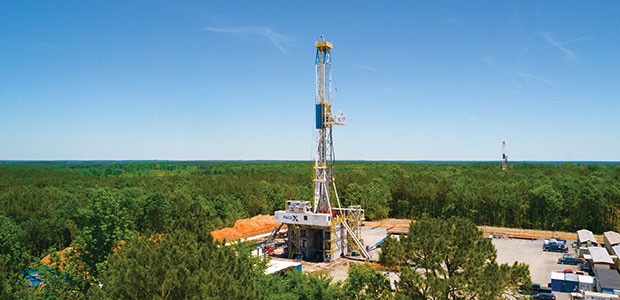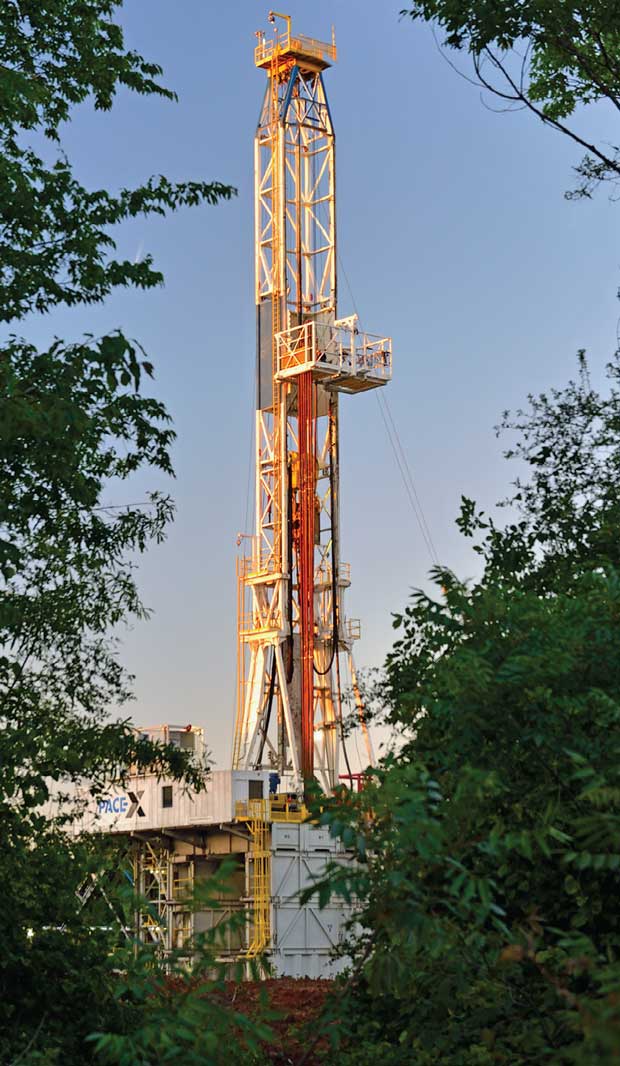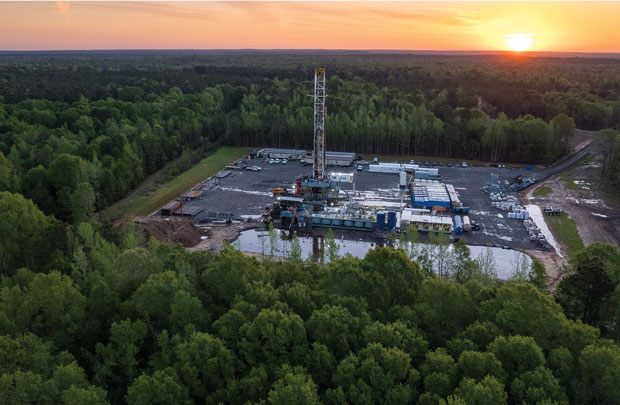
Top-Tier Haynesville Operators Drive Development Strategies, Future Growth Potential
By Al Pickett, Special Correspondent
While leading Haynesville producers may be cooling their jets with respect to the pace of drilling, they say they are actively expanding their acreage portfolios in anticipation of growing liquified natural gas export demand.
Comstock Resources was among the first companies to enter the Haynesville play back in its infancy, and now has drilled more than 900 wells in the play. The Circle M No. 1 well in Robertson County, Tx., has proven to be much more than just another Haynesville/Bossier well, in more ways than one, according to Comstock Chairman and Chief Executive Officer M. Jay Allison.
Comstock went 3,000 feet deeper than most Haynesville and Bossier wells with the Circle M well. The well drilled to a vertical depth of 16,000 feet with a lateral just under 8,000 feet long, a feat that Allison says would have been technologically difficult only a few years ago.
“We put it on line and it has produced 30 million cubic feet a day consistently,” Allison exclaims.
This month marks the one-year anniversary of the Circle M No. 1 commencing production, and Allison claims it is still making 30 MMcf/day. By comparison, he says most Haynesville/Bossier wells see a ±40% decline within the first year of productive life.
The success of the Circle M sparked enthusiasm that Comstock Resources was on to something big. Comstock moved a rig back into the “new” play that it calls the Western Haynesville and drilled a second well, the Cazey Black No. A1 to 16,000-foot vertical depth with a 7,900-foot lateral.
Additional Acreage
This time, Comstock installed larger production tubing and the well achieved an initial production of 42 MMcf/d. Buoyed by that success, Comstock Resources quietly scooped nearly 100,000 additional acreage on the Texas side of the state line last year.
“We added 98,000 net acres at $550 an acre,” Allison says. By comparison, other notable Haynesville players were paying as much as $30,000 an acre when the leasing land rush in the Haynesville first began some 15 years ago, he recounts.
The additional acreage gives Comstock Resources a substantial footprint of 470,000 net acres in the Haynesville play. It also acquired the Pinnacle processing plant in Leon County, Tx., and a 145-mile pipeline, in the second quarter of 2022. Allison describes the processing plant as located “on the spine” of the company’s newly acquired acreage. He says the plant has a capacity of 300 MMcf/d-350 MMcf/d, giving Comstock the ability to gather and process its own natural gas from its new discoveries and create a competitive price advantage.
Comstock now has drilled a third deep well, the Campbell No. 2, with a 12,800-foot completed lateral. The Campbell well came on line in late March.
A fourth and a fifth well, the McCullough-Ingram No. 1 and Dinkins 36 No. 1, respectively, are now in the process of being drilled.
Large Position
“The fact is that 95% of all U.S. LNG shipping capacity is on the Texas/Louisiana Gulf Coast,” Allison explains. He says 10% of U.S. natural gas production is now exported overseas as LNG. That number will more than double in the future, he contends, as Europe becomes more dependent on U.S.-sourced natural gas. The Haynesville Shale is the most economical supply basin because of its close proximity to the Gulf Coast facilities, he reasons.
Allison claims Comstock Resources’ strategy is “completely different” from other companies, as the company is focused on exploration to find reserves while most of its competitors are focused on acquisitions to add drilling inventory.” After laying down two rigs as gas prices have dropped, Comstock still has five rigs operating in the traditional core of the Haynesville/Bossier play and two rigs drilling the deeper wells in the newly acquired acreage in the Western Haynesville.
Comstock Resources says its strategy to drill deeper and longer laterals is nothing new. The Frisco, Tx.-based company’s experience mirrors the up-and-down history of the broader Haynesville play.
Seeking to consolidate around its Western Haynesville exploratory success, Comstock Resources added 98,000 net acres in 2022 at $550 an acre. The additional acreage expands Comstock’s Haynesville/Bossier shale leasehold to 470,000 acres in the play, and added new processing and gathering capacities in the new area. The company’s circle M No. 1H success has the company looking at deep horizons in the Western Haynesville.
Allison, who has been the company’s CEO for 36 years, says Comstock was one of the first operators—along with Petrohawk (which is credited with discovering the Eagle Ford in 2008) and Chesapeake (which officially discovered the Haynesville that same year)—to drill deeper than the historic Cotton Valley formation, initially drilling down 10,000 feet into the Haynesville Shale and using horizontal drilling techniques perfected in the Barnett Shale. Today, most Hayesville and Bossier wells average 10,000-13,000 feet in vertical depth.
The Haynesville Shale was long known to contain gas, but its low permeability shale matrix left it in the category of an unproduced “source rock” for many years. Like other shale formations, however, the combination of horizontal drilling and multi-stage hydraulic fracturing completely changed the historical definition. However, gas prices fell within a few years of the play’s discovery, slowing development. For its part, Comstock responded by ceasing drilling in 2011, but held onto its acreage. Comstock was the first company to resume drilling in the play in 2015 using longer lateral and enhanced competition techniques, Allison says.
According to the company, Comstock drilled nine wells in 2015 and another 13 wells in 2016. In 2018, Dallas Cowboys owner Jerry Jones acquired a majority stake in Comstock. Then in 2019, Jones put an additional $475 million into Comstock, upping his total investment to $1.1 billion and giving him 65% of the company’s stock as its leading shareholder. The capital was used to acquire Covey Park Energy for $2.2 billion, making Comstock Resources the largest operator in the Haynesville Shale with 1.1 Bcfe per day of production at the time.
The company says its low cost structure and robust drilling inventory allowed it to ride out the Covid downturn while improving its balance sheet and securing a new $1.5 billion unused bank credit line and refinancing its long term debt.
With the stronger balance sheet, Comstock green-lighted the deep Circle M No. 1H exploratory well in Robertson County. “We had hundreds of well logs to use for geologic analysis,” Allison details. “The question was whether it was technically viable to drill deeper and higher-pressured wells.”
Allison claims Comstock now has the largest acreage footprint and the largest drilling inventory in the Haynesville with a strong balance sheet and a sector-leading low cost structure. He says Comstock’s break-even Henry Hub price is $2.00-$2.10 an Mcf.
Filling The Supply Gap
“The fundamentals of natural gas changed with Russia’s invasion of Ukraine,” Allison emphasizes. “Russia was providing 15 billion cubic feet a day to Europe. Someone has to replace that. One supply source is Qatar LNG. The other is North American LNG.”
He says LNG will remain a key source for energy in Europe. Right now, 12 Bcf/d-13 Bcf/d of U.S. natural gas production is exported as LNG to Europe and Asia and another 6 Bcf/d is shipped by pipeline to Mexico. He predicts demand will increase 9 Bcf/d-12 Bcf/d by 2025-26 and another 6 Bcf/d-12 Bcf/d by 2030.
“Many people don’t realize it, but Norway is the seventh largest natural gas producer, and Norway recently indicated that Europe will have hard time getting enough gas during the next two winters,” he offers. “The simple truth is that Europe is short on gas supply.”
Allison contends the Haynesville Shale is well positioned to provide much of that increased demand for natural gas, and he says Comstock Resources will be a leader in that effort, with almost 1,600 identified potential drilling locations.
In the fourth quarter, Comstock reported that it drilled 73 (57 net) successful wells targeting the Haynesville and Bossier shales, including the two successful exploratory wells in Robertson County.
Comstock increased average lateral length by 14% in 2022 as compared with 2021, reaching 9,989 feet and achieving a strong average initial production rate of 26 MMcfe/d. Its 2022 drilling program drove 9% reserve growth with 1.1 trillion cubic feet equivalent of drilling-related reserve additions, achieving an overall finding cost of $0.95 an Mcfe, according to the company’s fourth-quarter report.
In Louisiana, Comstock operates in DeSoto, Red River, Bossier, Webster, Bienville, Caddo and Sabine parishes. On the Texas side, it operates primarily in Harrison and Panola counties along with its exploratory activity in Robertson County. Allison adds that LNG shippers, with their major infrastructure investments, need a consistent supply of natural gas, and Comstock’s new discoveries in Robertson County that show minimal first-year decline give them that reliable long-term supply.
When Comstock drilled its first well in DeSoto Parish in 2008, Allison admits, he had no idea what the company was sitting on. Now, 23% of the natural gas from the Haynesville Shale play comes from DeSoto Parish, and the Haynesville is in the bullseye for future natural gas supply.
“Jerry Jones has publicly said on numerous occasions that he think his ownership of Comstock Resources may become more valuable than his ownership of the Dallas Cowboys,” Allison concludes.
Extending The Core
Rockcliff Energy, a private company based in Houston, played a major role in extending the core of the Haynesville play to the west into East Texas, according to Chris Simon, the company’s vice president for business development.
“In 2017, we made a couple transformative acquisitions,” he explains. “We got started drilling in late 2017 and brought our first pads on line in early 2018. We have been drilling in East Texas ever since, running four rigs on a steady basis.”
Rockcliff has drilled more than 230 Haynesville Shale wells over the past five years, all in East Texas. Although the company’s total position of 272,000 acres is spread over six counties, which Simon describes as “fairly contiguous,” most of its activity has been focused in Panola and Harrison counties. Rockcliff has about 1.3 Bcfe/d gross production (about 1 Bcfe/ net) from the Haynesville.
When Rockcliff first acquired its acreage, Simon claims there were not many wells in East Texas that had utilized modern completion technology.
Rockcliff Energy has helped lead the way in extending Haynesville development activity westward, drilling its first wells on the Texas side of the play in 2017. Rockcliff has drilled more than 230 Haynesville Shale wells in East Texas, concentrated in Panola and Harrison counties, and is producing about 1.3 Bcfe/d gross production (about 1 Bcfe/d net) from the Haynesville. Rockcliff’s holdings in East Texas allow the company to stagger laterals in upper and lower Haynesville intervals.
“We did the geologic work and mapped our acreage six ways to Sunday,” he points out. “There is a huge amount of gas in place in our portion of the Haynesville, and we saw it was a great opportunity. We felt we could utilize modern fracturing methods and technologies that were being in the Louisiana side of the Haynesville over in the East Texas Haynesville, and we were right.”
One of its advantages, according to Simon, is that most of the company’s acreage is held by legacy production from zones such as the Cotton Valley, Travis, Pettit and James Lime.
“The legacy assets represent only a small percentage of our production, but serve to hold a significant portion of our leases,” he relates.
He notes that the Haynesville is much thicker in East Texas compared with the original core in Louisiana, which allows Rockcliff to employ staggered laterals in both the Upper and Lower Haynesville intervals.
“Since most of our acreage is held by legacy production, that allows our reservoir engineers and geologists to pick the locations (to drill) instead of our landmen,” he maintains.
Simon says Rockcliff typically drills three-four wells per pad, although sometimes it will drill only two per pad based on lease geometries and other factors. “Our wells are all Haynesville, and we typically turn the corner around 11,000 feet vertical depth,” he states. “We have some longer laterals, including East Texas records of 15,000 feet, but that is not our typical plan. Our average lateral length is a little more than 11,000 feet.”
He also claims that Rockcliff has been a leader in ESG achievement in the Haynesville play, and implemented Project Canary’s TrustWell environmental certification system in 2021 to assess emissions from its facilities and Haynesville wells.
“We do not flare any gas,” Simon offers. “We keep track of emissions and we keep our emissions extremely low. We also hired a vice president of ESG. We want to be good stewards of the environment. That is important to the investment community and to the public. That allows us to manage our wells effectively.”
Simon maintains that Rockcliff manages its flow assurance and basis differentials, as well as actively hedging its commodity price exposure. With a number of commitments, he says the company has good pipeline connectivity and access to multiple markets.
An average East Texas Haynesville well makes 20 MMcf/d-30 MMcf/d initial production rates with a flatter decline than what is typical from wells in North Louisiana, primarily due to the geological difference, according to Simon.
“I am excited about the future of natural gas, especially the Haynesville, because of our location and close proximity to LNG facilities,” Simon enthuses. “We see increasing demand, and we are in a strategic location to get our gas on the water to export around the world.”
For other great articles about exploration, drilling, completions and production, subscribe to The American Oil & Gas Reporter and bookmark www.aogr.com.








